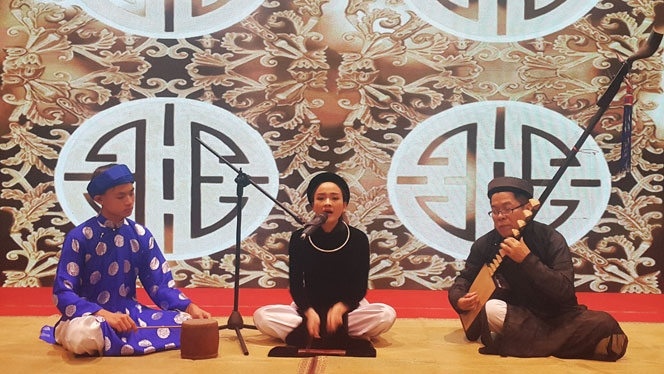This art genre has been increasingly developed both in terms of quantity of clubs and their quality in Hanoi, one of the largest cradles of Ca Tru in the country. The activities of Ca Tru singing clubs and guilds have contributed to preserving and promoting its artistic value, thereby creating a lasting vitality for the artform.
Preserving and passing on heritage
Meritorious Artisan Bui The Tien, deputy head of the Ngai Cau Ca Tru Club in Hoai Duc district expressed his belief and optimism about the club’s development as well as the preservation of the heritage in the locality despite the postponement of many performances and training programmes due to the COVDI-19 epidemic. With great efforts in recent years, a young force was trained to help Ngai Cau village’s Ca Tru go a "long way". Artisan Tien said: “While avoiding crowds to prevent the epidemic, we asked the club’s members to train, review and search for Ca Tru songs that are at risk of being lost”.
With singer Nguyen Kim Ngoc from the Phu Thi Ca Tru Club in Gia Lam district, Ca Tru seems to be imprinted in his heart and mind following many years of attachment. Therefore, the interruption of the performance schedule due to COVID-19 has not greatly affected the heritage’s practitioners. She said: “I still focus on improving my skills and research ancient melodies to enrich my knowledge”.
Like Ngai Cau and Phu Thi, many other Ca Tru clubs in the capital city have not faced difficulties in the preservation and promotion of the heritage in the context of the COVID-19 epidemic. This partly confirms the positive results following many years of making efforts to bring Ca Tru from the brink of being lost back to its current strong existence in contemporary life. At a time when Ca Tru was listed among Intangible Cultural Heritages in Need of Urgent Safeguarding by UNESCO, Hanoi only had a few clubs. However, there are now nearly 20 groups and clubs regularly performing and over 50 people with the ability to pass it on to younger generations. The clubs have preserved over 30 ancient styles, songs and dances while developing an additional 20 new melodies.
It is worth mentioning that Hanoi is also the leading locality in the number of people’s and meritorious artisans as well as holding the most regular performances of Ca Tru, attracting large crowds. Deputy Head of the Management Board of Hoan Kiem Lake and Hanoi Old Quarter Tran Thi Thuy Lan said that spaces promoting Ca Tru have not only created an attractive highlight for tourism in Hanoi’s Old Quarter but also offer opportunities for artisans and managers to exchange experiences in preserving and passing on the heritage’s value to younger generations.
Further support
The fact that UNESCO put Vietnam’s Ca Tru into its list of Intangible Cultural Heritages in Need of Urgent Safeguarding affirms this heritage’s value to humanity. In order to preserve and promote the Ca Tru art and enhance its lasting vitality, music researcher Dang Hoanh Loan said that along with efforts from the communities, the further support of specialised agencies and local authorities in providing operating funds and preferential policies for artisans, organising teaching activities and developing performing spaces is very essential. In terms of teaching and passing on to ounger generations, it is crucial to focus on training singers and instrument players in accordance with high standards to ensure quality.
Professor To Ngoc Thanh, Chairman of the Vietnam Folk Arts Association, notes that it is necessary to create favourable conditions for the performances and practice of Ca Tru, fostering a sustainable vitality. In addition, Ca Tru should be taught as extra-curricular lessons at school, he added.
Head of the Department for Heritage Management under the Hanoi municipal Department of Culture and Sports Pham Thi Lan Anh said that in recent years, the city’s authorities have made great efforts to revive and develop this genre. In addition to seminars on preserving and promoting the heritage’s value, Hanoi’s cultural sector has enhanced its research and documentation of Ca Tru songs and melodies that elderly artisans harboured; supported the expansion of spaces at several relic sites and landscapes in association with tours; and organised many festivals and contests to create “playgrounds” for Ca Tru practitioners as well as to seek young talent.
According to the head of Dong Anh District’s Cultural and Information Department Nguyen The Manh, the district will continue to see financial investment in opening classes to teach Ca Tru amongst young people, purchasing musical instruments and performance costumes, and helping Ca Tru clubs develop.
Ca Tru bears a unique feature that is not found in any other art form. Thanks to the efforts made by agencies at all levels and people, Hanoi’s Ca Tru has not only been preserved but has been gradually entering contemporary social life with a new and lasting vitality.




